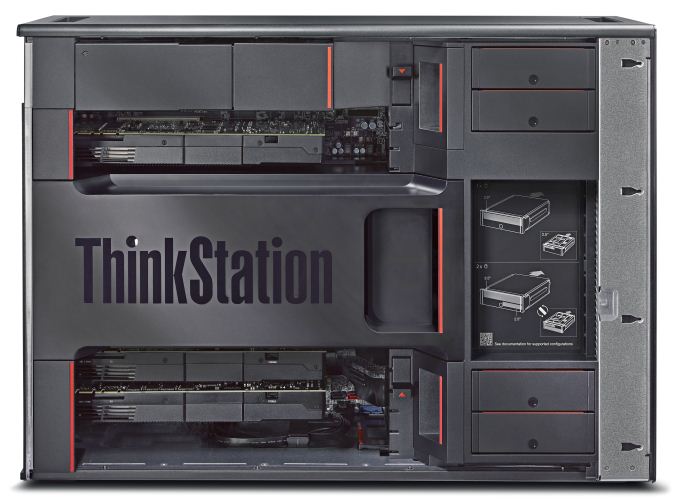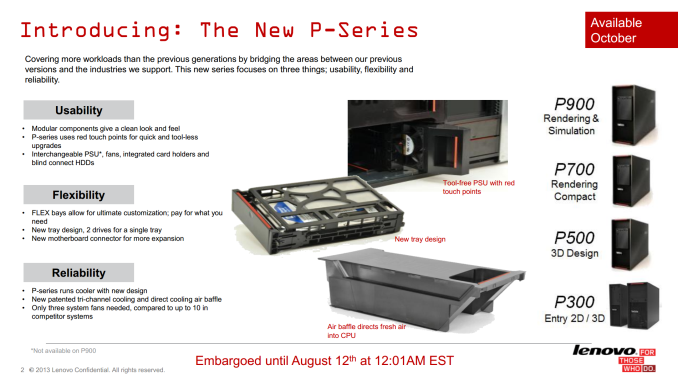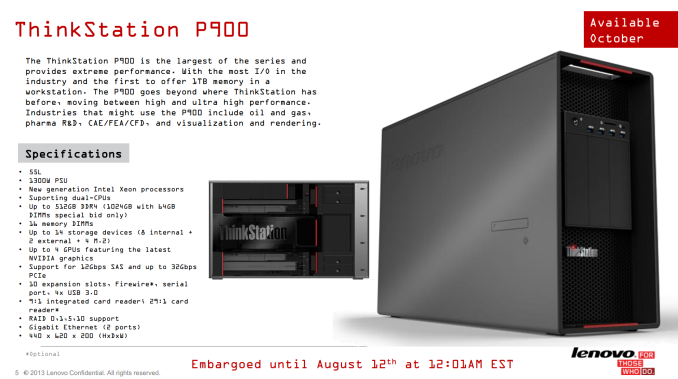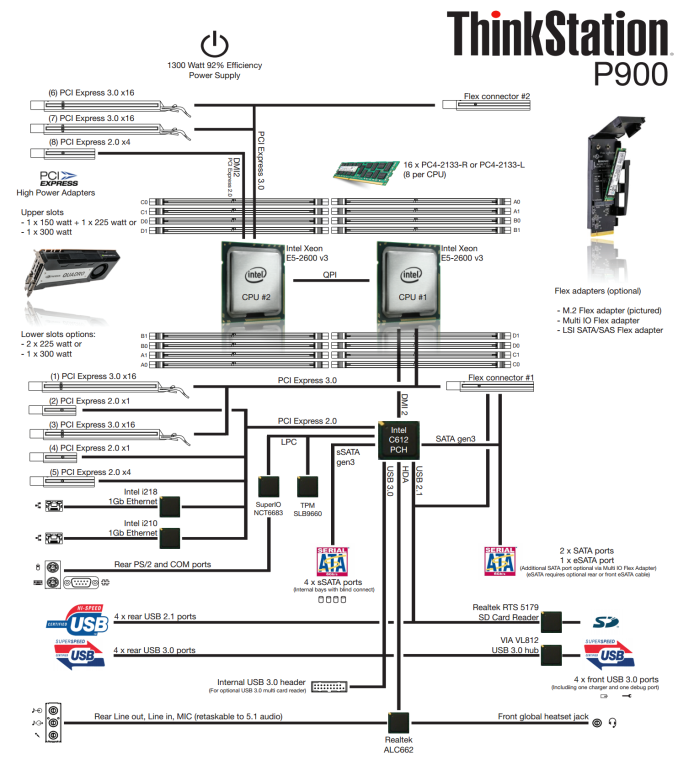The Lenovo ThinkStation P900 Workstation Review: Design 101
by Ian Cutress on May 6, 2015 7:00 AM EST
The workstation market has always been a consistent seller. The dream of offloading to an on or off-site VM and a cluster for work processing still lies more in the realm of mass production over local quick-to-compute work, and because of that low latency for quick interaction, workstations are here to stay. While the consumer is going smaller, business aims to scale and on the back of our P300 review, Lenovo sent their 34kg dual Xeon E5 v3 behemoth version of the ThinkStation P900 for review.
Lenovo ThinkStation – The Range
When designing a workstation, the teams have to think of the two main people that will interact with it. On one side is the user who will want quick response times, a specific feature set and the ability to complete intense compute tasks quickly. A company such as Lenovo can enable this through motherboard design, component pricing and adapting the preinstalled software. This includes getting official ISV certification for many of the professional level applications that someone might want to use a workstation for.
The other side of the equation is that the system has to be suitable for the person who is repairing or upgrading it over the lifetime of the unit. The ability to easily remove, diagnose or replace components on the hardware side helps avoid downtime and improves overall work efficiency. So far in our foray of reviewing workstations some of them have been built to be proprietary and difficult, whereas others adhere to standard base unit design principles.
This is where Lenovo's new ThinkStation design is planned to attack. We reported on the official announcement at the end of last year, with the P500, P700 and P900 range getting the full overhaul in terms of ease of use along with industrial design.
At the time, Lenovo promised air baffles for directional flow and a Flex system to allow hybridization of specific functionality depending on the customer need. Ryan was lucky enough to see a demo unit in the flesh around the same time as the announcement, and I received numerous emails and tweets about the design. Well I am glad to say that Lenovo has now sent us one to review. We were sent the P900 no less, featuring the top of the line in design and weighing in at almost $17000. The only way this could get more expensive would be through denser memory or more PCIe coprocessors. The P900 can hold three NVIDIA K6000s (or Xeon Phi based derivatives) along with a single slot PCIe card.
The full specification of our sample gives two Intel Xeon E5-2687W v3 processors - these are the high TDP 160W models with 10 cores at 3.1 GHz (3.5 GHz Turbo) each that we reviewed at the end of last year that retail at almost $2140 apiece. These are paired with the NVIDIA Quadro K5200, an 8GB Kepler based GK108GL with 2304 CUDA cores running at 650 MHz. For the DRAM, our sample came with eight modules of 8GB DDR4-2133 ECC from SK Hynix.
| Lenovo ThinkStation P900 | |
| Processors | 2 x Intel Xeon E5-2687W v3 (160W) 10 Cores, 20 Threads, 3.1 GHz (3.5 GHz Turbo) |
| Motherboard | Lenovo Custom |
| Cooling | Aluminium Heatsink with Copper Heatpipes and Fan |
| Power Supply | Delta 1300W 80 PLUS Platinum |
| Memory | SK Hynix 128GB (16x8) DDR4-2133 ECC RDIMM |
| Memory Settings | 2133 15-15-15 |
| Video Cards | NVIDIA Quadro K5200 8GB 2304 CUDA Cores, 650 MHz core, 256-bit |
| Hard Drive | Samsung XP941 512GB PCIe 2.0 x4 M.2 SSD |
| Optical Drive | Yes |
| Audio | Realtek ALC662 |
| Networking | Intel I218-LM Intel I210 |
| Case | Lenovo ThinkStation 2P |
| Operating System | Windows 7 64-bit SP1 with Downgrade Rights from Windows 8 |
| Front Panel | Power Button SD Card Reader 4 x USB 3.0 |
| Rear Panel | Audio Jacks PS/2 Mouse PS/2 Keyboard COM Port 2 x Intel NIC (I218-LM and I210) 4 x USB 2.0 4 x USB 3.0 DVI-I (Quadro) DVI-D (Quadro) 2 x DisplayPort (Quadro) |
| Warranty | 3 Years On-Site |
| Pricing | Starts at $1830 with 1x E5-2609 v3, Quadro K620 Review system at $16,797.60 |
The P900 sits atop the ThinkStation range with dual Xeon E5-2600 v3 processors, starting (from the website) at $1830 with a single E5-2609 v3 (six cores, no HT, 1.9 GHz) with one module of DDR4-2133 memory and an NVIDIA Quadro K620 (Maxwell, 2GB, 384 CUDA cores at 1000 MHz) discrete card. This is in comparison to the P700 which focuses on a compact 2P Xeon build and the P500 which is a 1P Xeon system but still based on the LGA2011-3 socket.
Clearly the first port of call for criticism off the bat is going to be the list price, and I agree, for the specifications Lenovo's pricing seems way off, similar to that of the P300 we reviewed last year. Lenovo's answer stems from the fact that they get almost zero sales from the website, which acts as a business-to-consumer frontage, but the ThinkStation range is more often sold as a business-to-business unit either directly to the vertical industries (financial, medical, defense, oil and gas) which often get volume discounts or don't care about pricing, or as an OEM to resellers who buy closer to list and can add their own components. Lenovo's attitude in this final case is that they don't want to compete with their resellers, who may ultimately be able to offer a better deal/support package to individual consumers buying single units.
Despite the individual pricing, as a unit and by extension the company, the P900 and Lenovo are lucky. This is the first true high end halo workstation product we've reviewed at AnandTech for a long while, and Lenovo has pulled out the bells and whistles on the high end designed to dazzle and amaze. We are in talks to get similar systems from HP and Dell, however my lack of experience with their designs means that for now, Lenovo has my undivided attention.
Chipset Analysis
We asked Lenovo for the Chipset diagram, so users can see how each of the CPUs are routed with regards to the PCIe lanes:
Given the level of functionality that Lenovo is going for with the P900, a lot of the pathways here make sense in order to maximize bandwidth and location. Both of the Flex connectors are PCIe 3.0 x8, allowing for the FLEX modules to use whatever hardware they need. The front USB 3.0 ports are provided by the VIA VL812 hub, with one of the ports acting as an always-on charger port. Perhaps the only downside to the specifications here is the Realtek ALC662 audio codec, which is best described as a poor laptop audio solution. Most motherboard and system manufacturers at this point use an ALC892 as the bare minimum, or an ALC898/ALC1150 which sit at the top of the stack for less than a few cents over the cost of the ALC662. Now ultimately users can add their own audio cards, and the P900 isn’t particularly designed for audio, but the laptop-class codec shouldn’t be here.













61 Comments
View All Comments
Freakie - Thursday, May 7, 2015 - link
Actually in my experience we do the vast majority of the servicing ourselves, especially for desktops. Literally all I have to do is live chat with Dell's support for IT Departments, tell them that a computer we recently received had the power connector going into the DVD drive break off inside the DVD drive some how, and they next day ship me a replacement PSU and my user has a working DVD drive within 24hrs. And THAT'S what good manufacturer support is, a trusting relationship between manufacturer and IT Department goes a long ways. Sending out equipment for repairs is slow and a pain. And having someone come on-site is a waste of money for the manufacturer and time for us because we need to make sure we are available when they get there instead of repairing it on our own schedule. If you're a "real IT department" for a few hundred computers, you really can't afford the time to have someone else do the repair work.And you'd also be surprised how many things that SHOULD have been EoL'd don't get EoL'd! Just because it isn't under warranty doesn't mean we want to just throw it out especially when you have 100 of the same thing (aka spare parts which means immediate repairs). And some departments are happy with what they have and don't want to go by the set EoL schedule for their computers and use their funds elsewhere. They pay for it with extra downtime when something does break, but they know that it's their own fault.
Samus - Friday, May 8, 2015 - link
My HP servers, workstations and printers order parts that fail\deplete automatically. When I show up to work the next morning at 8AM, the support technician that arrived at 6AM is walking out the door and everything is fixed.That's real support. And it's included with every HP Elitedesk/Elitebook, Laserjet Pro\Officejet Pro, and Proliant server I've ever managed for 3 years unless you purchase a "smartbuy" with a 1y/1y. The craziest thing about HP warranties is the ADP (accidental damage protection) is only 6%/year the cost of the machine. So a $1000 Elitebook is <$200 to cover for 3 years against user destruction. The equivalent Applecare on a $1000 Macbook is $269, and Lenovo charges $229 with no option for next-day.
zavrtak - Friday, May 29, 2015 - link
Small business solutions without internal it department often likes easy to service, replace and upgradeable hardware. Not only because those solutions might offer good value for their money in small business solutions, but as well because external IT consulting likes to make a buck with their own support.Besides that you are absolutely right. If there is a real IT department than usually they prefer to buy support, reliability and just cycle out stuff that stop working - with a few exceptions when old hardware is needed for special use-cases or getting some time for bigger rollouts.
KAlmquist - Wednesday, May 6, 2015 - link
I don't think that the system is particularly hard to service. To remove the power supply (and only the power supply), you remove the side panel, open a door, and slide the power supply out. I assume that the Dell has something that keeps the power supply from accidentally falling out of the case when the side panel is removed, so I would think that remove the power supply from the Dell takes the same number of steps, or more.To access the DIMM's you remove the side panel and the central baffle. Removing the baffle is an extra step, but before we can say definitively that the Dell wins on this measure we would have to compare the time to remove the side panel on both systems.
As for fans that slide in and out, I'll grant you that fans don't fail very often, but if one ever does fail the Lenova allows you to slide out the failed fan and slide in a replacement after removing nothing other than the side panel.
I agree with you about price. I couldn't find a comparable computer on the Dell web site, but AVA Direct will sell a comparable computer for a tad over $10,000. The P900 is only worth considering if you need a large numbers of workstations and can get Lenovo to agree to a large quantity discount.
Freakie - Thursday, May 7, 2015 - link
That's the problem though, being built for too many "what if's". And I hate break-out boards in units too, they are notorious for dying and don't really serve a purpose that a different internal design can't solve. The design of the P900 is just so superfluous. Just having the insides look pretty is a waste because no one is looking at the insides, and of course there is no side window. It just screams unnecessary.The Dell Precision 7910 is the one I was referencing in my original comment. I specced it out online and it came out to ~$5,000 less than this and I doubt that you are going to get a $5,000 discount per-unit on these Lenovos. And if you're ordering that large of a volume, might as well ask your Dell rep for a volume discount as well.
dragonsqrrl - Saturday, May 9, 2015 - link
Yep, I did the same and it came out to around 10,500-$11,000. Based off of this review I too prefer the internal layout of the latest Precisions, they're simple and well thought out. Definitely an improvement over the prior design at least.edlee - Wednesday, May 6, 2015 - link
I have had great experience with Lenovo professional products, thinkserver tower and rack servers similar well thought design and high end power supply. Please try to review an 8 bay thinkserver as well so we can compare to commercial 8 bay naszachrohlfs - Wednesday, May 6, 2015 - link
Would really appreciate some benchmark scores from programs like Solidworks, Revit, Adobe Suites and graphic design programs.While the review is nice it makes it hard to sell anything to a company with out some comparable data on the programs you use.
mapesdhs - Wednesday, May 6, 2015 - link
PS. Ian, pleeeease stop using the Blinkenlights site for the C-ray link! :D I don't control that site, it's just a mirror. The main C-ray link should be here:http://www.sgidepot.co.uk/c-ray.html
Sometimes I can't even connect to Blinkenlights.
Ian.
gey27 - Wednesday, May 6, 2015 - link
The advertising on the sides of the page is extremely off-putting. The ad is so close to the article text that it is making the article difficult to read. I have been coming to this site religiously since before the days of the celeron (the abit BP6 brings back many fond memories) and almost all my computer related purchases are based in part on reviews here. But this latest style is a bridge too far. Please fix it, or I'll be forced to look elsewhere.....